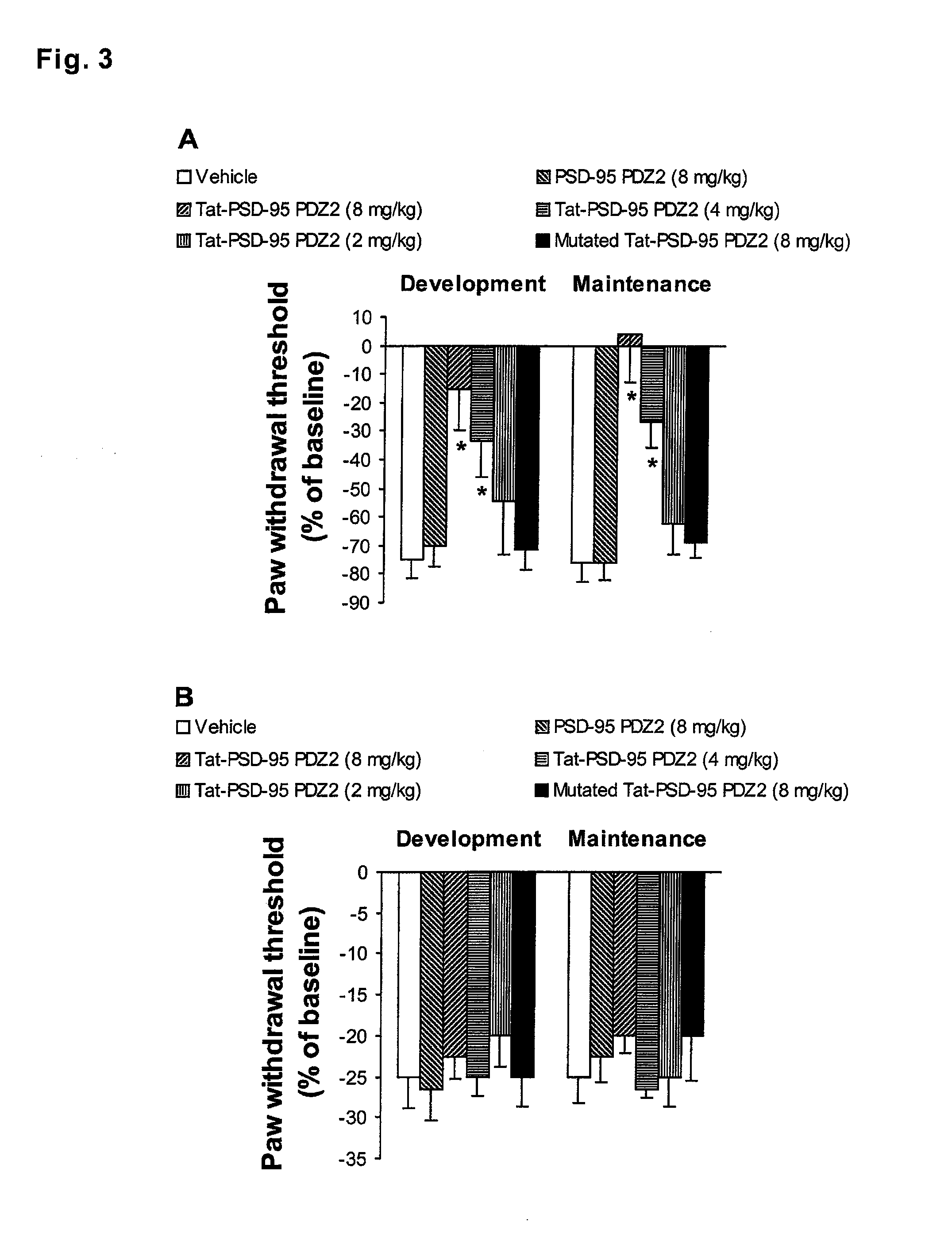Biological agents active in central nervous system
a technology of biological agents and central nervous system, applied in the direction of drug compositions, peptide sources, peptide/protein ingredients, etc., can solve the problems of reducing the threshold for anesthesia, and affecting the effect of pain therapy
- Summary
- Abstract
- Description
- Claims
- Application Information
AI Technical Summary
Benefits of technology
Problems solved by technology
Method used
Image
Examples
example 1
Materials and Methods
[0055]Animal Preparation. Male C57B1 / 6J mice 8-10 weeks old were obtained from Jackson Laboratories (Bar Harbor, Mass.) and acclimated in our animal facility for a minimum of 1 week prior to use in experiments. Mice were housed under standard conditions with a 12-h light / dark cycle and allowed food and water ad libitum. All animal experiments were carried out with the approval of the Animal Care and Use Committee at Johns Hopkins University, and adhered to the guidelines of the Committee for Research and Ethical Issues of IASP and the National Institutes of Health guide for the Care and Use of Laboratory Animals (National Institutes of Health Publications No. 8023, revised 1978). All efforts were made to minimize animal suffering, to reduce the number of animals used, and to utilize alternatives to in vivo techniques, if available.
[0056]Construction and Purification of Tat Fusion Peptide. The cDNA encoding the second PDZ domain of PSD-95 was prepared in our labo...
example 2
[0073]Delivery of Tat Fusion Peptides by PTD. After incubation with Tat-PSD-95 PDZ2 or PSD-95 PDZ2 for 30 min, the cultured spinal neurons were processed to determine whether these peptides containing 6×His were transported into the neurons. Western blotting with anti-His antibody showed that the His-peptide was only detected in the neurons treated with Tat-PSD-95 PDZ2 (FIG. 1A), but not in the neurons treated with PSD-95 PDZ2 or medium alone (FIG. 1A). Furthermore, Western blot analysis and immunohistochemistry were employed to define whether Tat fusion peptide was distributed in the spinal cord after systemic administration. We found that after mice were given intraperitoneally injections of the fusion peptides, Tat-linked fusion peptides (Tat-PSD-95 PDZ2 and mutated Tat-PSD-95 PDZ2), but not PSD-95 PDZ2 without Tat, were delivered into lumbar spinal cord (FIG. 1B). Moreover, Tat-PSD-95 PDZ2 was delivered into the spinal cord in a dose-dependent manner (FIG. 1B). No difference was...
example 3
[0074]Disruption of NMDAR / PSD-95 Protein Interactions by Tat-PSD-95 PDZ2. GST pull-down and co-immunoprecipitation assays were used to discover whether NMDAR / PSD-95 protein interactions were disrupted by Tat fusion peptides. We found that Tat-PSD-95 PDZ2 markedly disrupted the interactions between NMDAR NR2 subunits and PSD-95 (FIG. 2). However, mutated Tat-PSD-95 PDZ2 had no effect (FIG. 2).
[0075]In the GST pull-down assay, both GST-PSD-95 PDZ1,2 and NMDAR subunit NR2B were pulled down by glutathione-agarose (FIG. 2A). Preincubation with Tat-PSD-95 PDZ2 dose-dependently reduced the amount of NR2B, and the treatment with a high dose (16 μg) of Tat-PSD-95 PDZ2 completely prevented NR2B from being pulled down (FIG. 2A). In contrast, preincubation with different doses of mutated Tat-PSD-95 PDZ2 had no effect on the interactions between GST-PSD-95 PDZ1,2 and NR2B, and NR2B was pulled down by glutathione-agarose at a similar level under these conditions (FIG. 2A).
[0076]After mice were gi...
PUM
| Property | Measurement | Unit |
|---|---|---|
| pH | aaaaa | aaaaa |
| excitation wavelength | aaaaa | aaaaa |
| angle | aaaaa | aaaaa |
Abstract
Description
Claims
Application Information
 Login to View More
Login to View More - R&D
- Intellectual Property
- Life Sciences
- Materials
- Tech Scout
- Unparalleled Data Quality
- Higher Quality Content
- 60% Fewer Hallucinations
Browse by: Latest US Patents, China's latest patents, Technical Efficacy Thesaurus, Application Domain, Technology Topic, Popular Technical Reports.
© 2025 PatSnap. All rights reserved.Legal|Privacy policy|Modern Slavery Act Transparency Statement|Sitemap|About US| Contact US: help@patsnap.com



